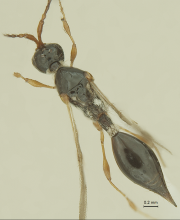 Fig 1. Female, dorsal view |
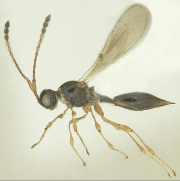 Fig 2. Female, profile |
 Fig 3. Head, dorsal view |
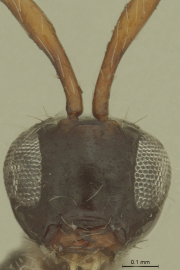 Fig 4. Head, front view |
|
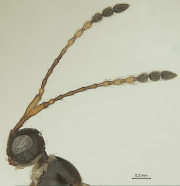 Fig 5. Antenna (female) |
 Fig 6. Forewing |
 Fig 7. Mesosoma |
 Fig 8. Metasoma |
 Fig 9. Mesopleura |
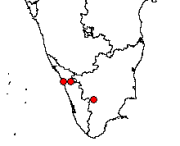 Fig 10. Distribution map |
|
Nomenclature
Oxypria Kieffer, 1908: 37. Type species: Oxypria thoracica Kieffer.
Diagnosis
1.5-2mm long, delicate to robust forms. Head and body brown to black, with appendages usually lighter in colour, body smooth and shining, lacking micropilosity, but with sparse long semierect hairs, hairy cushion often well developed on post gena, sides of pronotum and upper part of propleuron, foamy structures sometimes indicated, particularly on axillar regions and petiole.
Head often globose. Antennal shelf well developed in lateral view. Antennae 12-segmented in females and 14-segmented in males, clothed with scattered pilosity, much longer than width of A2, in females pilosity denser towards clava. Clava non-abrupt, number of claval segments 3-5. Male antenna filiform, segment 3 subequal to 4, A4 usually modified, slightly emarginate and carinate. Vertex unarmed, eye size variable. Mandibles normal, bidentate, never developed into a beak. Malar sulcus rarely developed. Occipital flange distinct, but not step-like.
Cervix distinct, often smooth. Pronotal shoulders curved. Mesoscutum without notauli and humeral sulcus. Anterior scutellar pit monofoveate. Scutellar sheath at times medially with a carina. Lateral and posterior scutellar pits absent, sternaulus feebly indicated. Dorsellum with three keels medially, propodeum sometimes elongate, with dense long pilosity laterally. Median keel anteriorly produced into a prominent pointed spine. Nucha indicated in some cases.
Wings usually well developed, venation extending only to one-third of forewing length. In forewings, submarginal vein moderately close to wing margin. Costal cell extremely narrow. Marginal vein short, postmarginal vein absent, stigmal vein very much reduced. Basal vein usually absent, but at times nebulous and arcuate. Marginal cilia well developed, length nearly one-fifth of forewing width. Submarginal vein on hindwings complete.
Petiole usually longer than wide, with longitudinal striae, often partially concealed by tufts of hairs and also foam-like scaly structures. Anterior margin of T2/ large tergite at an elevated level of petiole and without a median furrow or emargination. Metasoma elongate oval, basal tergites telescoped under large tergite, visible as narrow rings only, tip extremely pointed in females.
Geographic Distribution
See Indian distribution map (Fig.10).
Species known from India
1. Oxypria kodaikanalensis Sharma
2. Oxypria kottooliensis Rajmohana & Narendran
3. Oxypria spinosa Rajmohana & Narendran
Remarks
Not common in collections. A rather small genus characterised by a smooth, shining body, well developed hairy cushions on post gena, pronotal collar and on petiole, normal mandibles, 12-segmented female and 14-segmented male antennae, clava non-abrupt in females, absence of notauli, presence of monofoveate scutellar pit, a pointed spine on median propodeum, forewings without a tubular basal vein.
References
|